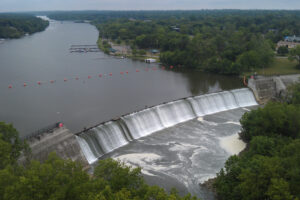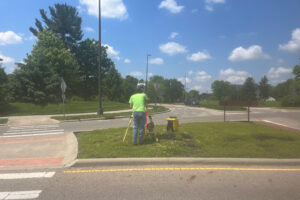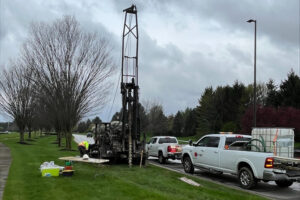“When the well is dry, we learn the worth of water” ~ Benjamin Franklin
FAQs
Overview
The City of Columbus Department of Public Utilities is building a new water plant and transmission mains to prepare for the growing need for clean, safe drinking water in central Ohio.
 Central Ohio is expected to grow from about 2.5 million residents to more than 3 million by 2050. As we plan for the future, Columbus needs to provide clean, safe drinking water for everyone.
Central Ohio is expected to grow from about 2.5 million residents to more than 3 million by 2050. As we plan for the future, Columbus needs to provide clean, safe drinking water for everyone.The Home Road Water Plant will be built along the Scioto River at the intersection of Home and Dublin roads in Delaware County. Water transmission mains will connect the new plant to the Columbus water distribution system near the Blazer Parkway area and other strategic areas in northwest Columbus.
The City of Columbus Department of Public Utilities owns and operates three water plants, collectively supplying an average of 145 million gallons of drinking water daily to Columbus and surrounding central Ohio communities.
The eventual need for a fourth water plant has been known since the department’s “Water Beyond
2000″ planning documents from the 1990s and early 2000s. Due to regular evaluation of future needs
by the Division of Water, more detailed planning for the fourth water plant and transmission mains has
been underway for several years, including the 2015 purchase of the land where the water plant will be
built.
 The new Home Road Water Plant and transmission mains will benefit over 20 communities in central Ohio. Many residents in these areas receive their water bill from Columbus. Even if the bill doesn’t say “Columbus,” other central Ohio communities buy water in bulk from Columbus and handle their billing. We are building to ensure that clean water is available and ready to use. Residents in Concord Township and Delaware County use water from Del-Co Water Company but may work in areas where they drink water provided by Columbus.
The new Home Road Water Plant and transmission mains will benefit over 20 communities in central Ohio. Many residents in these areas receive their water bill from Columbus. Even if the bill doesn’t say “Columbus,” other central Ohio communities buy water in bulk from Columbus and handle their billing. We are building to ensure that clean water is available and ready to use. Residents in Concord Township and Delaware County use water from Del-Co Water Company but may work in areas where they drink water provided by Columbus.You can track progress on this project by bookmarking and checking this website. New information will be added as it becomes available.
Home Road Water Plant
Yes. In 2012, as part of the City’s water master plan analysis, it was determined that a new water plant should be located near the available water source supply at the Scioto River. The State of Ohio sold the land, the former location of a juvenile correctional facility, to the City of Columbus in 2015.
While Intel was not on the radar in the late 1990s, the City of Columbus master plan accurately forecasted central Ohio’s new business and population growth. As more companies have announced their intention to relocate here in the last five years, building the plant has become necessary.
We are developing architectural plans for the plant buildings. The city desires to utilize an architectural style compatible with the area.
AEP serves the east side of the O’Shaughnessy Reservoir and Scioto River, while First Energy serves areas to the west. We are working with First Energy because the plant is in their service area.
The exact routing and size of electrical power lines have not been determined. First Energy will be responsible for those decisions. However, it is anticipated that large overhead power lines/poles will be needed to reach a substation on the city’s water plant property at the intersection of Dublin and Merchant roads. On-site solar power will offset and supplement the water plant’s electrical needs. Solar power will be available only during the day and is independent of the electric power lines.
Currently, Moore Road is planned as a dedicated haul route to deliver excavated rock being removed from the water plant site to one of two possible quarries. The project team will reevaluate and confirm if this is the best and safest possible route.
Water Plant Transmission Mains
Fourteen corridors were considered to connect the water plant transmission mains with the Columbus Public Utilities water distribution system near the Blazer Parkway area and other strategic areas in northwest Columbus. An advisory committee of representatives from local political jurisdictions was consulted and provided input on possible routes. The evaluation process considered EPA water pressure requirements, environmental and property impacts, shallow rock/high groundwater, schedule, risks, costs, and other factors like utility conflicts and travel impacts. The recommended corridors emerged as the most viable according to these evaluation factors.
Transmission main construction aims to remain in the public right-of-way to the extent possible, but some private easements may be required. We are asking the public to provide input on where private wells, septic systems, landscaping features, ingress and egress points, etc., are located in the corridors so that the final alignments can avoid them to the extent technically feasible. Property owners can provide that information on the website at https://cbuswater.com/contact/.
Two separated transmission mains provide reliability, resiliency, and the ability to flow the volume of future plant expansion. If something happens to one main, the other main will act as a backup to avoid anyone losing access to the water produced at the plant.
“Reliability” is the quality of a trustworthy, stable, and consistent environment over time. “Resiliency” is related to reliability but involves preparing for, operating through, and recovering from any disruption.
The goal is to keep the two mains as far apart as possible. However, this isn’t always practical due to many factors, including geography, environmental impacts, community considerations, and project cost. The separation distance between the two transmission mains will be optimized during the final design process.
Merchant Road was considered an alternate transmission main corridor instead of Home Road, Blaney Road, or Cook Road. It was initially eliminated due to First Energy’s potential need to use it to extend overhead high-voltage power lines to a new electrical substation on the Home Road Water Plant property. We have since learned that the First Energy alignment has not been finalized; Cook Road and Merchant Road will be re-evaluated. A secondary consideration is that the Home Road Water Plant property, owned by the City of Columbus, extends south along Dublin Road to Cook Road. We would minimize community impacts by keeping the recommended alignment on plant property to the maximum extent possible. The team is aware of the number of trees along Cook Road, and if the final corridor extends on this route, we plan to minimize property and tree impacts by staying within the road right-of-way as feasibly possible. During final design, we will also investigate placing both mains within the AEP easement corridor between Cook Road and Harriott Road.
Both transmission mains will be located on the east side of Dublin Road, outside the right of way, where possible, and on City of Columbus property as far south as Cook Road.
The Home Road Water Plant must convey water across the river into Columbus’s water distribution system to best feed the network of pipes.
Transmission main corridors C, D, and E were dismissed partially because the increase in ground elevation along these routes would cause water pressure within the mains to fall below the EPA’s regulatory minimum of 20 pounds per square inch (psi). Click HERE for the corridor alternative map. Frequent low water pressure may pose contamination risks and require residents to boil their water before use.
The top of the transmission main will be buried 6 feet deep from the surface. The goal is to use an open-cut installation rather than trenchless methods. The city prefers open cuts so that service crews can access the mains for repairs from the surface after construction. Vibrations may occur during construction but will be very localized to the site. If you have concerns about vibrations on your property, please contact the project team HERE, and we can discuss installing monitors during construction.
No. The water transmission mains won’t directly serve individual businesses or residents. The mains will convey treated water from the new water plant to the water distribution system near the Blazer Parkway area at Frantz Road and Parkcenter Avenue, and other strategic connection points. The water will then fill the system and flow similarly to how it currently does.
Financial
The Home Road Water Plant and the transmission mains projects are in their final design phases. The preliminary cost of the Home Road Water Plant is $1.35 billion, and the two water transmission mains are estimated at $511 million.
These projects will be funded with a below-market-rate loan through the Ohio EPA’s Water Supply Revolving Loan Account (WSRLA) program.

Due to the Columbus Division of Water’s regular evaluation of future needs, planning for the Home Road Water Plant and transmission mains projects has been underway for several years, including the 2015 purchase of the land where the water plant will be built. This planning is reflected in the annual rate reviews to minimize sudden increases, even for large projects. In other words, rate calculations have reflected these projects and others for several years through regular, modest increases instead of abrupt jumps when the projects are finalized.
Columbus’s utility rates are generally lower than those of other midwestern cities of similar size. The rates are set to spread costs across multiple years so that those who will benefit the most from these infrastructure projects will share in the costs. The projected increase in the population in central Ohio aids in the distribution of costs.
Construction Impacts
For the Home Road Water Plant, the early Site Preparation Contract begins in early 2025 and aims to be completed by late 2027. Construction of the water plant starts in late 2025 and should wrap up by the end of 2030.
Construction on the first transmission main is anticipated to begin in winter 2026 and be completed in 2028. Construction for the second transmission main, connectors, and extension should start in winter 2029 and be completed in 2030.
Project schedules are subject to change due to weather and other factors.
The Site Preparation Contract includes the construction of a new electrical substation, site clearing, bedrock removal in preparation for the water plant construction, new turn lanes on SR 745 to access the plant, stormwater detention ponds, and sediment and erosion control.
The goal is for transmission main construction to occur within the public right-of-way wherever possible and for the transmission mains to be installed mostly under existing roads. This may not always be possible.
During the final design phase, the project team will evaluate the best routes within the selected corridors to minimize or avoid major property impacts to businesses and residents. Affected roads, pedestrian paths, drainage ditches, storm sewers, and landscaping will be restored to pre-existing conditions. Each community has specific requirements that will be followed.
Yes. Once final design activities identify road impacts, we will develop a traffic maintenance/detour plan to minimize traffic impacts as much as possible. This plan will include detour signs, flaggers, and other communication to alert the public before the work begins in their area. We will also coordinate with local jurisdictions so they can share information with their residents and businesses directly.
During construction, the contractor must maintain police, fire, and emergency medical services access at all times.
Most excavated soil will be hauled away, though some will be used for fill. During the final design, we will evaluate which roads may be used for haul routes.
Before constructing the transmission mains, we will convene a public meeting to share more specific details. Generally, when work is performed in the road frontage along the transmission main routes, residential and commercial property owners may be temporarily inconvenienced by construction traffic, noise, dust or mud, and disturbed lawns or pavements. Individual driveway ingress and egress may be restricted to allow time to trench, lay pipe, and backfill dirt. The contractors must provide advanced notice to affected property owners and maintain access. Such inconveniences are expected to occur during pipe installation and later when lawns and surface pavements are permanently restored.
Environmental Impacts

The City of Columbus Division of Water prioritizes environmental stewardship, and the Home Road Water Plant is being designed with sustainability as a foundational principle. This includes stream restoration and wetland preservation, solar energy and electric vehicle charging stations, and stormwater management. The Home Road Water Plant will also pursue LEED certification for the administration building and Envision certification for the entire water plant site.
Additionally, our environmental teams will specifically identify environmental concerns so that proper avoidance or mitigation measures can be implemented. Every potential environmental impact will be identified and, when possible, avoided or minimized in coordination with applicable regulatory agencies.
Neither water quality nor supply will be affected for current customers. Any planned service interruptions during construction caused by construction will be limited and communicated in advance.
During the design phase, the project team will monitor and measure wells adjacent to the transmission main corridors and develop a plan to mitigate the impacts of dewatering the wells.
We need your support in locating active wells. If you live adjacent to the recommended transmission main corridors (click HERE for the corridor alternative map) and have an active well for drinking water or irrigation on your property, please provide that information to the project team by filling out a comment form at https://cbuswater.com/contact/. Please let us know if you have a drinking water service supplied by Del-Co or Dublin, an active well for drinking water, and an active well for watering animals or irrigation/landscaping.
The Home Road Water Plant will draw water from the O’Shaughnessy Reservoir, which is already operating to maintain consistent water levels in the Scioto River. The City of Columbus has a drought management strategy that prevents the overuse of the Scioto River even during drought conditions.
The extent of any boating impacts is unknown at this stage in the project. Some infrastructure will be installed in and along the O’Shaughnessy Reservoir as part of the Home Road Water Plant. The project team is working with the appropriate agencies to minimize and mitigate any impacts to boating.
The Home Road Water Plant project will comply with the stormwater and floodplain regulations set forth by the City of Columbus, Delaware County, and Ohio EPA. All necessary permits have been obtained. Construction of the water plant will not cause flooding, and any flooding issues that arise during construction will be remedied.
Stormwater management plans will be prepared for the transmission main projects for the contractor to follow during construction. If you own a property adjacent to the transmission main corridors and have drainage issues, please get in touch with the project team HERE.
Controlled underground blasting operations are essential to remove the underlying harder, solid rock where several deep, below-grade structures are proposed on the water plant site. This blasting is tentatively scheduled for the plant site between 2025 and mid-2026, subject to change.
Blasting is not anticipated to be used on the transmission main project. Transmission main trenches are shallower, and preliminary subsurface investigations indicate we will encounter soil and fractured rock along most of the recommended corridors. We will use saws and other mechanical means to cut the harder solid rock we anticipate during trench excavations in localized areas.
Much of the construction will occur in the public right-of-way and will not disturb historic properties. If you own a historic property adjacent to the transmission main corridors and have specific questions or concerns, please get in touch with the project team HERE.
The project team is taking steps to protect and preserve the historical landmarks on the plant site (i.e., the gazebo and the Ohio Home Cemetery). These historical landmarks will continue to be maintained and preserved by the City of Columbus during and upon completion of the construction. Access to the cemetery will be provided post-construction.
We will evaluate and preserve trees to the fullest extent possible. Should any trees need to be removed, we will adhere to local policies as we remove and replace them.
The water transmission mains are anticipated to be installed within the roadway to minimize disruption to landscaped areas throughout the Muirfield Drive corridor, consistent with our goal to preserve trees and landscaping within the median. Construction operations will likely disturb portions of the median lawn area immediately adjacent to the pavement, but it will be replaced to pre-construction conditions.
The Home Road Water Plant is anticipated to use treatment chemicals similar to those currently used at the Dublin Road Water Plant and the Hap Cremean Water (both in densely populated areas), which meet or exceed regulatory requirements. Appropriate chemical unloading and spill containment measures will be used to minimize any chemicals leaving the site.
Property & Community Impacts
The City of Columbus owns all the land where the Home Road Water Plant will be built. Some private property impacts beyond public right-of-way limits may occur for the transmission mains. However, the project team is evaluating the best routes within the selected corridors during final design activities to minimize or avoid major property impacts to businesses and residents. If we determine that your property will be affected, such that an easement is required, we will contact you. Information about how public agencies are required to address property impacts in Ohio can be reviewed HERE.
To confirm any specific concerns about impacts on your property, contact the project team on the website at https://cbuswater.com/contact/.
Columbus will collaborate with event organizers to develop event-specific plans to schedule around those events or temporarily suspend construction operations in the immediate vicinity and relocate work crews to other project areas. Construction materials and equipment will be removed, and surface conditions restored as much as practical in advance to provide patrons with safe access during the various events.
School districts west of the Scioto River should anticipate temporary inconveniences when construction activities occur adjacent to their facilities and along bus routes. Dublin City Schools bus routes will be affected by transmission main construction east of the Scioto River along the Tuller Road corridor between Riverside Drive and the Sawmill/Snouffer intersection. The project team will coordinate with the school districts during the design phase so they can provide input on bus routing. Additionally, we will provide timely updates during construction.
Jurisdictional Coordination

Yes. Columbus is working closely with jurisdictions along the possible route alignments for the transmission mains. Policy-level and technical representatives from each jurisdiction were invited to participate in an advisory group (including the City of Dublin, Concord, and Jerome townships, Shawnee Hills, Delaware and Franklin counties, and others). This body has contributed local data, reviewed study documents, and provided invaluable input on the project. Columbus has also presented to the Dublin City Council and Concord Township Trustees at their meetings.
Yes. The City of Columbus invited the Concord Township trustees to serve on the advisory committee, briefed them at their May 2024 township meeting, and will continue coordinating with Concord Township at each opportunity to develop the transmission mains.
Yes. During the final design, the project team will coordinate with utility companies to avoid existing infrastructure, allowing the engineering team to develop the final alignment of the transmission mains.
Technical Terminology

Surveying is the collection of topographical data points (latitude, longitude, and elevation of the ground) and objects (utilities, landscaping, edge of pavements, etc.). These data points are used to create detailed construction plans.

Soil boring involves drilling a hole into the ground to collect soil and rock samples. This process determines the soil’s physical and chemical properties and assesses the site’s suitability for various engineering needs. Soil boring ranges from 15’ to 30’ deep.

A monitoring well is a hole drilled into the ground to measure water level elevation. Pipe jackings are used within the ground or to obtain a representative groundwater sample. These temporary wells will be filled once investigations are complete, and the area will be restored to its previous condition.
Open-cut installation involves digging a trench across the alignment area, laying the water line, and then backfilling the trench with dirt. Open-cut methods will be used where the pipeline runs within roadways and does not impact obstacles like sewers or streams.
Trenchless construction involves subsurface work that requires few trenches or no continuous trenches, such as installing pipelines below the ground with minimal excavation. From the areas of limited excavation, the pipe can then be pushed or drilled through the ground with heavy machinery. This construction method includes pipe jacking, micro tunneling, and horizontal directional drilling.
Pipe jacking involves workers digging a large vertical shaft called a “launch pit” at the tunnel’s starting point. This pit accommodates the equipment and the pipes. Large, strong pipes made of concrete or steel, known as casing pipes, are used. A jacking machine with hydraulic jacks is placed in the launch pit. These powerful devices push the pipes horizontally through the ground. Once the first pipe is almost entirely underground, another pipe is added behind it, and the process continues until the tunnel reaches its destination. The soil displaced by the pipes is removed using an auger or flushed out with water. Finally, the pipes emerge at a “receiving pit” at the end of the tunnel. This method minimizes surface disturbance since most work is done underground.
Micro tunneling is similar to pipe jacking, starting with a launch pit for the equipment and pipes. A micro tunnel boring machine, which is small but technologically advanced, is used. The boring machine has a rotating cutting head that bores through the soil guided by a precise laser system to ensure accuracy. As the boring machine advances, it pushes the soil out while simultaneously pushing in pipes that line the tunnel, creating a sturdy passageway. The removed soil is transported back to the surface through the pipes using a slurry system or an auger. This process is also suitable for rock conditions.
Horizontal directional drilling (HDD) is a minimal-impact trenchless method of installing underground utilities in a relatively shallow arc or radius along a prescribed underground path using a surface-launched drilling rig. Horizontal directional drilling is unsuitable for our project as our pipes are too large. HDD is typically used for smaller-diameter pipes, such as gas mains or underground phone line conduits.
The test involves four narrow pins that will be driven into the ground, and a special meter will record the measurements. No permanent impacts to your yard or property are expected.
An ecological survey assesses the potential ecological impact of a proposed development. A professional ecologist will conduct a field walk and a shallow soil excavation to observe the possible presence of these resources. This may include any environmental impact a proposed development may have on natural resources, such as streams, wetlands, vegetation and listed species.
A professional archaeologist will conduct a field walk to examine evidence of any remnant architectural features and prehistoric mounds. If these resources are present, the archaeologist will also conduct subsurface investigations, which involve a series of shovel test pits excavated at 50-foot intervals for documentation. Upon completion, test pits will be refilled, and no loose soil will be visible.
Arborists will conduct field walks to develop and document a tree inventory. This includes identifying each tree’s species, size (diameter), and condition.


